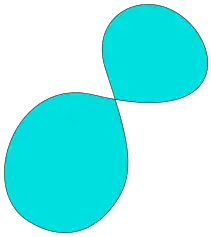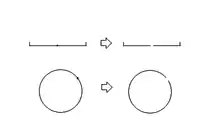
In topology, a cut-point is a point of a connected space such that its removal causes the resulting space to be disconnected. If removal of a point doesn't result in disconnected spaces, this point is called a non-cut point.
For example, every point of a line is a cut-point, while no point of a circle is a cut-point.
Cut-points are useful to determine whether two connected spaces are homeomorphic by counting the number of cut-points in each space. If two spaces have different number of cut-points, they are not homeomorphic. A classic example is using cut-points to show that lines and circles are not homeomorphic.
Cut-points are also useful in the characterization of topological continua, a class of spaces which combine the properties of compactness and connectedness and include many familiar spaces such as the unit interval, the circle, and the torus.
Definition
Formal definitions

A cut-point of a connected T1 topological space X, is a point p in X such that X - {p} is not connected. A point which is not a cut-point is called a non-cut point.
A non-empty connected topological space X is a cut-point space if every point in X is a cut point of X.
Basic examples
- A closed interval [a,b] has infinitely many cut-points. All points except for its end points are cut-points and the end-points {a,b} are non-cut points.
- An open interval (a,b) also has infinitely many cut-points like closed intervals. Since open intervals don't have end-points, it has no non-cut points.
- A circle has no cut-points and it follows that every point of a circle is a non-cut point.
Notations
- A cutting of X is a set {p,U,V} where p is a cut-point of X, U and V form a separation of X-{p}.
- Also can be written as X\{p}=U|V.
Theorems
Cut-points and homeomorphisms
- Cut-points are not necessarily preserved under continuous functions. For example: f: [0, 2π] → R2, given by f(x) = (cos x, sin x). Every point of the interval (except the two endpoints) is a cut-point, but f(x) forms a circle which has no cut-points.
- Cut-points are preserved under homeomorphisms. Therefore, cut-point is a topological invariant.
Cut-points and continua
- Every continuum (compact connected Hausdorff space) with more than one point, has at least two non-cut points. Specifically, each open set which forms a separation of resulting space contains at least one non-cut point.
- Every continuum with exactly two noncut-points is homeomorphic to the unit interval.
- If K is a continuum with points a,b and K-{a,b} isn't connected, K is homeomorphic to the unit circle.
Topological properties of cut-point spaces
Irreducible cut-point spaces
Definitions
A cut-point space is irreducible if no proper subset of it is a cut-point space.
The Khalimsky line: Let be the set of the integers and where is a basis for a topology on . The Khalimsky line is the set endowed with this topology. It's a cut-point space. Moreover, it's irreducible.
Theorem
- A topological space is an irreducible cut-point space if and only if X is homeomorphic to the Khalimsky line.
See also
Cut point (graph theory)
References
- Hatcher, Allen, Notes on introductory point-set topology, pp. 20–21
- Honari, B.; Bahrampour, Y. (1999), "Cut-point spaces" (PDF), Proceedings of the American Mathematical Society, 127 (9): 2797–2803, doi:10.1090/s0002-9939-99-04839-x
- Willard, Stephen (2004). General Topology. Dover Publications. ISBN 0-486-43479-6. (Originally published by Addison-Wesley Publishing Company, Inc. in 1970.)